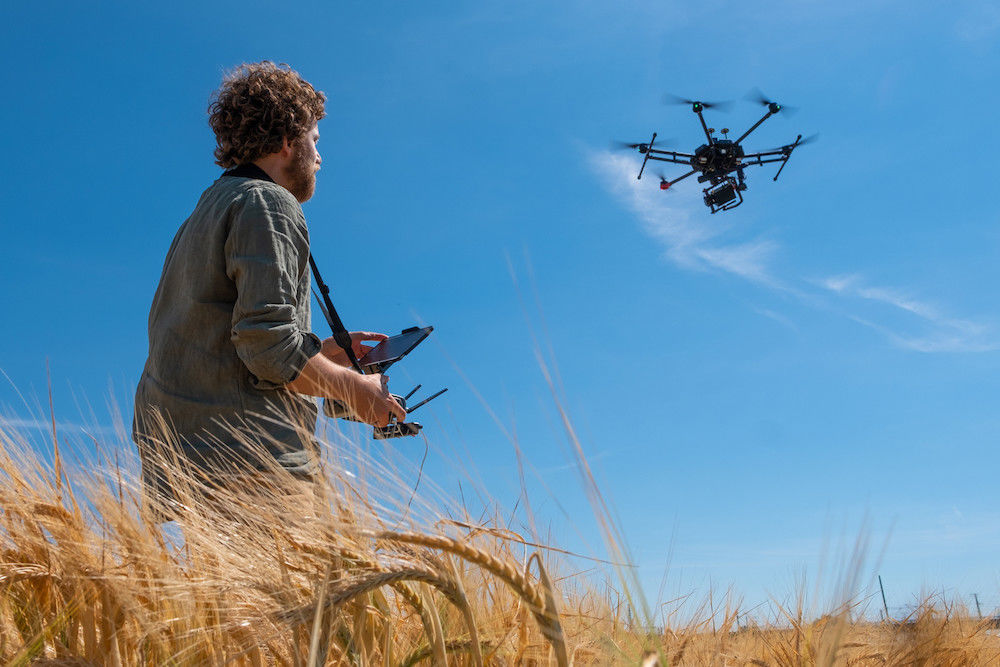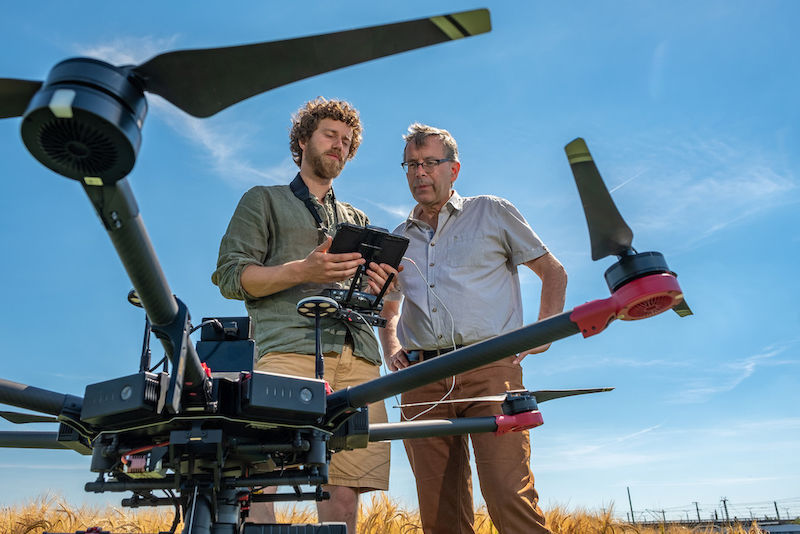Aerial photos from Scarlett

Scarlett – this name evokes associations with film actresses or the world bestseller “Gone with the Wind”. Only experts like Professor Klaus Pillen immediately think of crops. For the agricultural scientist, Scarlett is most im-portantly the name of a barley variety which, together with wild barley, has for four years been at the centre of a project to increase the crops' yield and biodiversity. To optimise their associated field tests in the teaching and experimental station, the researchers are now also breaking new technical ground.
PhD student Paul Herzig doesn’t even own a proper smartphone. But for a few months now, he has had a very special driving licence in his pocket. One that entitles him to control a technically sophisticated flying object, weighing twelve kilos and equipped with a swivel-mounted camera that is even used in Hollywood. The hexacopter, the name of this giant drone, whirs leisurely over the plots of land on the Julius Kühn field. The device flies over all the tiny field segments belonging to the current experiment. “We are very satisfied with his efforts so far,” says Klaus Pillen, who is supervising Herzig’s PhD and leading the project.
“BARLEY BIODIVERSITY” is the official title and it has been funded by the Federal Ministry of Education and Research (BMBF) since 2014 and aims to increase both biodiversity and the performance of various varieties of cultivated barley. In addition to the MLU plant researchers, scientists from the Leibniz Institute (IPK) in Gatersleben, the Fraunhofer Institute (IFF) in Magdeburg and Breun, a seed cultivation company, are also involved as partners.
Spring barley is at the centre of the joint research. The plant, which originally comes from the Middle East, is relatively undemanding and requires little fertilizer. “We mainly use it for brewing beer,” explains Pillen.
But cultivated varieties, such as the aforementioned cultivated barley Scarlett, have long been influenced by climate change. That means that when Scarlett was approved in 1995, there was more rainfall and less drought. “This is why we are now examining whether and how this change will affect their growth and yield,” says Pillen. To this end, chromosome sections from a variety of related wild barley were systematically crossed into the Scarlett cultivated barley to increase biodiversity.
In the current experiment, the resulting lines — how the researchers refer to these field segments — are observed and documented in a standardised way. The researchers hope to find out whether the crossed genes of wild barley are better able to cope with drought stress or heat, and how growth, flowering time, yield and other factors change overall.
The drone has been used in the experiments for a few months now. As it flies over the plants, the camera attached to it provides razor-sharp images. “In the beginning it was a technical challenge,” says Herzig. But the biologist says he has now optimised his flying technique. He now knows that the drone must reach an altitude of 30 meters. Only then will the wind from the rotors not set the plant stalks in motion too much, and only then will they be still enough to be photographed in a meaningful way.
The camera provides one image per second. It only takes ten minutes for the entire area to be covered. For comparison: in the first three years of the project, an automotive equipment carrier called AgRover was used for the same work. A mobile device suitable for field use, which was specially designed for this purpose by the Fraunhofer Institute in Magdeburg and which is equipped with special cameras and sensors for hyperspectral imaging.
Equipped in this way, the AgRover systematically drove the lines. However, it needed about two working days for the same area. “The time saved by the drone is huge,” says Klaus Pillen.
And how is subsequent analysis then presented? The data generated during the flyover is transferred to a computer. There, the images are rectified by software and broken down into segments. Photogrammetry is the associated method of remote sensing with which the spatial position or a three-dimensional form can be determined from photographs.
The planting density can therefore be determined just as precisely as the number of ears per grid square. This, in turn, can be used to derive state-ments about yield. “This was much more difficult with the previous methods,” explains Klaus Pillen.
But it is not only the innovative use of drones that makes the Halle plant researchers’ project so special. Its complexity is also striking: for one, according to Klaus Pillen, it is of course a matter of practical applicability, i.e. opening up new varieties for cultivation. However, the researchers also hope to understand and clarify the function of certain genes. “This is how we can increase the biodiversity of cultivated barley.”
Professor Klaus Pillen
Institute of Agricultural and Nutritional Sciences
Telephone +49 345 55-22680
Mail: klaus.pillen@landw.uni-halle.de

